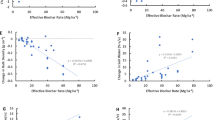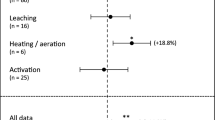Abstract
Biochars have potential value for greenhouse nurseries as a potting amendment, reducing the need for environmentally costly products currently in use. The onsite manufacture of biochars by pyrolysis of woody waste offers additional greenhouse value as a source of clean heat. However, recent work observed that some biochars may evolve ethylene gas, a plant hormone that has adverse effects on many nursery crops. We hypothesize that suitable post-production handling techniques would eliminate ethylene emissions. We monitored for 6 months ethylene emissions from four fresh biochars made from two feedstocks at two temperatures. We also monitored samples of expanded vermiculite for comparison. We then repeated the same testing on the same batches of biochars after they had been stored in the open for 90 days. Ethylene can affect plant development in greenhouses at concentrations as low as 10 ppb. Biochars sampled that were made from hazelnut shells at 370 °C emitted 161 to 183 μg ethylene kg−1 biochar on the first day of incubation and then tapered down slowly. Hazelnut shell biochars prepared at 620 °C emitted 37 to 43 μg ethylene kg−1 biochar the first day of incubation, but then increased slightly on the second day and did not begin to taper off until after day 14. Biochars made from Douglas fir wastes released small amounts of ethylene beginning on the second day, but ceased doing so after the first week. None of the biochars stored in the open for 90 days following manufacture emitted any ethylene. We conclude that this simple post-production handling technique renders biochars safe for use as nursery and greenhouse potting amendments, possibly replacing environmentally expensive expanded vermiculite and/or peat.




Similar content being viewed by others
References
Abeles FB, Morgan PW, Saltveit ME (1992) Ethylene in plant biology, 2nd edn. Academic, San Diego, 414 pp
Albright LF, Crynes BL, Nowak S (1992) Novel production methods for ethylene, light hydrocarbons, and aromatics. Marcel Dekker, NY
Argueso CT, Hansen M, Kieber JJ (2007) Regulation of ethylene biosynthesis. J Plant Growth Regul 26(2):92–105. doi:10.1007/s00344-007-0013-5
Arshad M, Frankenberger WT (1991) Effects of soil properties and trace elements on ethylene production in soils. Soil Sci 151(5):331–397
Arshad M, Frankenberger WT (2002) Ethylene: agricultural sources and applications. Kluwer/Plenum, New York
Brady NC, Weil RR (2008) The nature and properties of soils, 14th edn. Pearson-Prentice Hall, Upper Saddle River, p 934
Elsgaard L (2001) Ethylene turn-over in soil, litter and sediment. Soil Biol Biochem 33(2):249–252. doi:10.1016/s0038-0717(0)00122-X
Keiluweit M, Nico PS, Johnson MG, Kleber M (2010) Dynamic molecular structure of plant biomass-derived black carbon (biochar). Environ Sci Technol 44(4):1247–1253. doi:10.1021/es9031419
Lehmann J, Joseph S (2009) Biochar for environmental management: science and technology. Earthscan Ltd, London, 404 pp
Lehmann J, Rillig MC, Thies J, Masiello C, Hockaday WC, Crowley D (2011) Biochar effects on soil biota—a review. Soil Biol Biochem 43(9):1812–1836. doi:10.1016/j.soilbio.2011.04.022
Neljubow D (1901) Über die horizontale Nutation der Stengel von Pisum sativum und einiger anderer. Pflanzen Beih Bot Zentralbl 10:128–138
Primrose (1979) A review, ethylene and agriculture: the role of microbes. J Appl Bacteriol 46:1–25
Spokas K, Colosky E (2012) Presentation given at the US Biochar Conference held from July 30–Aug 1 at Sonoma State University, Rohnert Park, CA, USA
Spokas KA, Baker JM, Reicosky DC (2010) Ethylene: potential key for biochar amendment impacts. Plant Soil 333:443–452. doi:10.1007/s11104-010-0359-5
Yan J, Pan G, Li L, Quan G, Ding C, Luo A (2010) Adsorption, immobilization, and activity of b-glucosidase on different soil colloids. J Colloid Interface Sci 348:565–570. doi:10.1016/j.jcis.2010.04.044
Zhang X, Liu J, Jing Y, Xie Y (2003) Support effects on the catalytic behavior of NiO/Al2O3 for oxidative dehydrogenation of ethane to ethylene. Appl Catal A Gen 240(1–2):143–150. doi:10.1016/s0926-860X(02)00426-X
Acknowledgments
We would like to thank the Agricultural Research Fund at Oregon State University for funding our research. We would like to thank John Miedema at Starker Forests/Thompson Timber in Philomath, Oregon, USA, for manufacturing the chars, and Tom Jopson at Cal-Forest Nurseries in Etna, California, USA, and Tom Miles at T.R. Miles, Technical Consultants Inc., in Portland, Oregon, USA, for helpful advice.
Author information
Authors and Affiliations
Corresponding author
About this article
Cite this article
Fulton, W., Gray, M., Prahl, F. et al. A simple technique to eliminate ethylene emissions from biochar amendment in agriculture. Agron. Sustain. Dev. 33, 469–474 (2013). https://doi.org/10.1007/s13593-012-0118-5
Accepted:
Published:
Issue Date:
DOI: https://doi.org/10.1007/s13593-012-0118-5




